It’s one thing to buy the books and supples, to make a plan, to create a chart and quite another to actually pull it off in a typical day.
Days never go exactly as imagined, but it’s worth the time to imagine it even so – and the more you practice imagining it and planning for contingencies before the heat of the moment, the better you’ll become and rolling with the punches of a real-life homeschool day in a household bustling with people.
Listen to this post!
Here are three tools I use to help me put together an organized homeschool day.
Homeschool Weekly Time Budget
I never did implement a Managers of Their Homes schedule, but one thing I did learn from her book was that when I made a plan, I had to think about what everyone was doing. I couldn’t just schedule Latin with the two older kids while assuming the others would be productively occupying themselves without disturbing us. I couldn’t plan on doing reading lessons with a middle child and assume the older ones would work on independent work while the toddler would not wreak havoc.
Unrealistic expectations lead to frustration.
The problem there is that my expectations were unrealistic only because I wasn’t thinking through the whole picture. Once I looked objectively at the situation, it became obvious that my plan was incomplete and therefore did not work.
I needed a plan that took into account each person. I also needed a plan that didn’t hang over our heads like a dictator, where my job was beating everyone with the time tables rather than helping them with their lessons.

Enter the MOTH-style schedule. It looks like (and can easily become) an overbearing micromanaging torture device, but when used primarily as a tool to think through the whole situation, it’s brilliant.
I don’t schedule each person strictly every thirty minutes, but I do make a plan that notes where each person should be during our school hours. Then I can see that I need to have something for the preschooler to do or make it clear to the elementary student that now is when he should be practicing piano or getting to his checklist.
I have two school-day time budgets: one for our summer term, which is lighter than the rest of the school year, and one for the rest of our school year terms.
Summer Term Time Budget:

Here I can see that if we want to do something summer-fun in the morning, we can easily adjust by doing math & Morning Time before leaving the house and budget 90 minutes in the afternoon to lesson time – which, when it’s super hot in August, is often a preferable schedule anyway.
Primary Homeschool Time Budget:
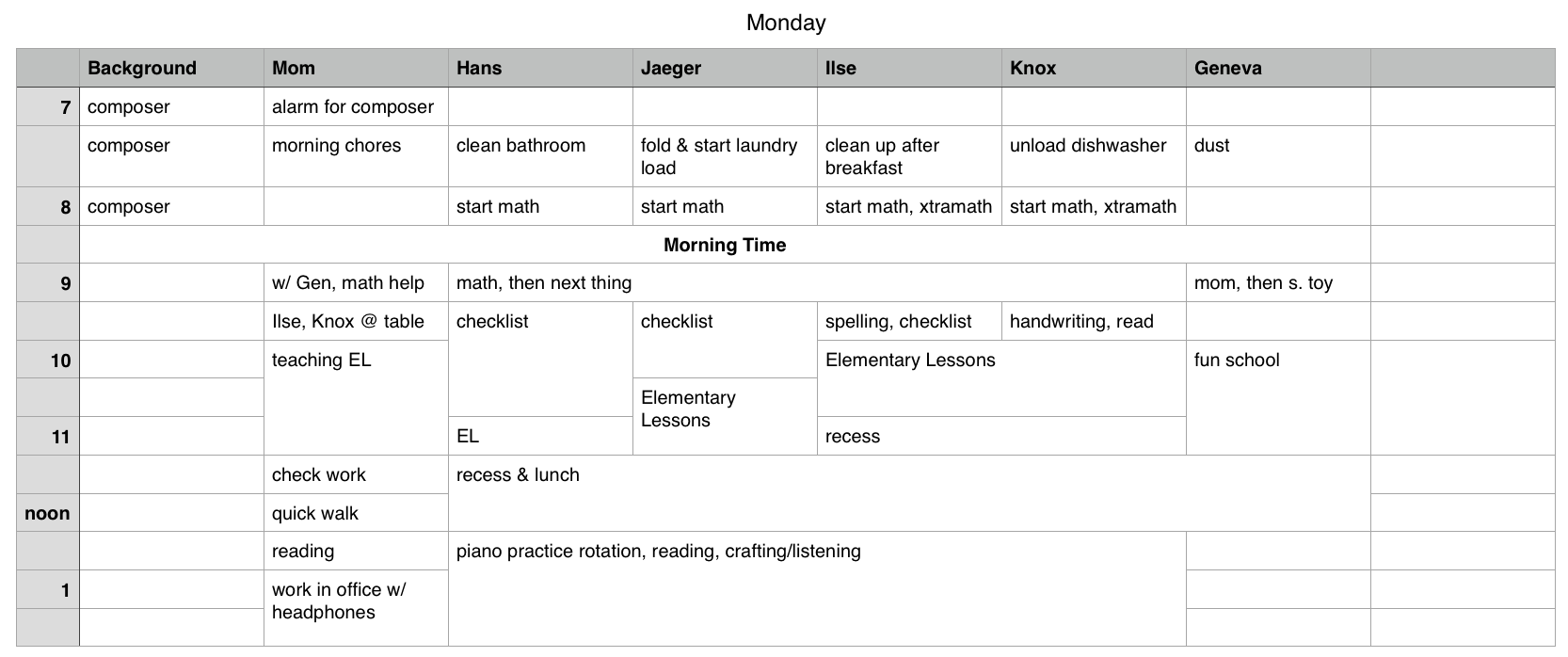
In this plan, I think there’s enough time for my 8th grader to get his work done, but there’s also a 90 minute “reading time” buffer. If he needs more time, it’s there. But if he gets his work done in the morning and wants listen to a podcast while playing Legos, he can do that instead.
Use Procedure Charts
The plan is made, the books are in the basket, I sit down with the children sitting around and then I freeze. What are we doing? How do I start? Didn’t I have an idea for a good way to do this?
Enter: procedure charts.
I learned this trick from Pam and I love it. I’ve always maintained that starting is the hardest part of anything, including each and every transition within a homeschool day. A procedure chart is a simple hack that has helped me overcome that mental hurdle of going blank when we sit down to begin a lesson.
It’s really just a list, but it’s such a helpful little list!
I make mine in Keynote, and I can quickly open it on my phone or iPad – because it’s the only file I ever have open in the Keynote app, it loads right away and is just a double-home-button-click away from any other app I might be in.
Here’s my Morning Time Procedure Chart:
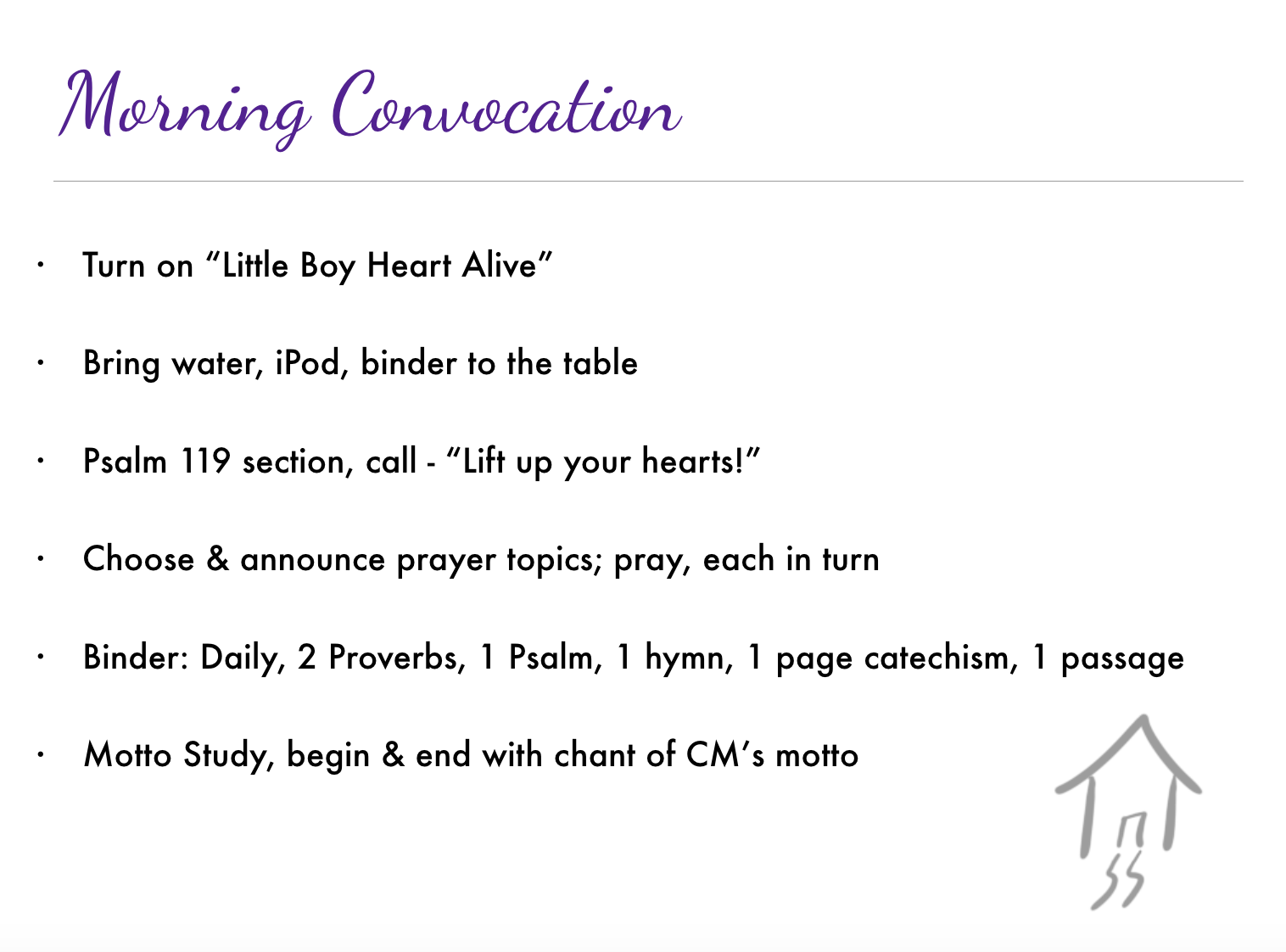
Here’s my Monday & Friday Meeting Procedure Charts:
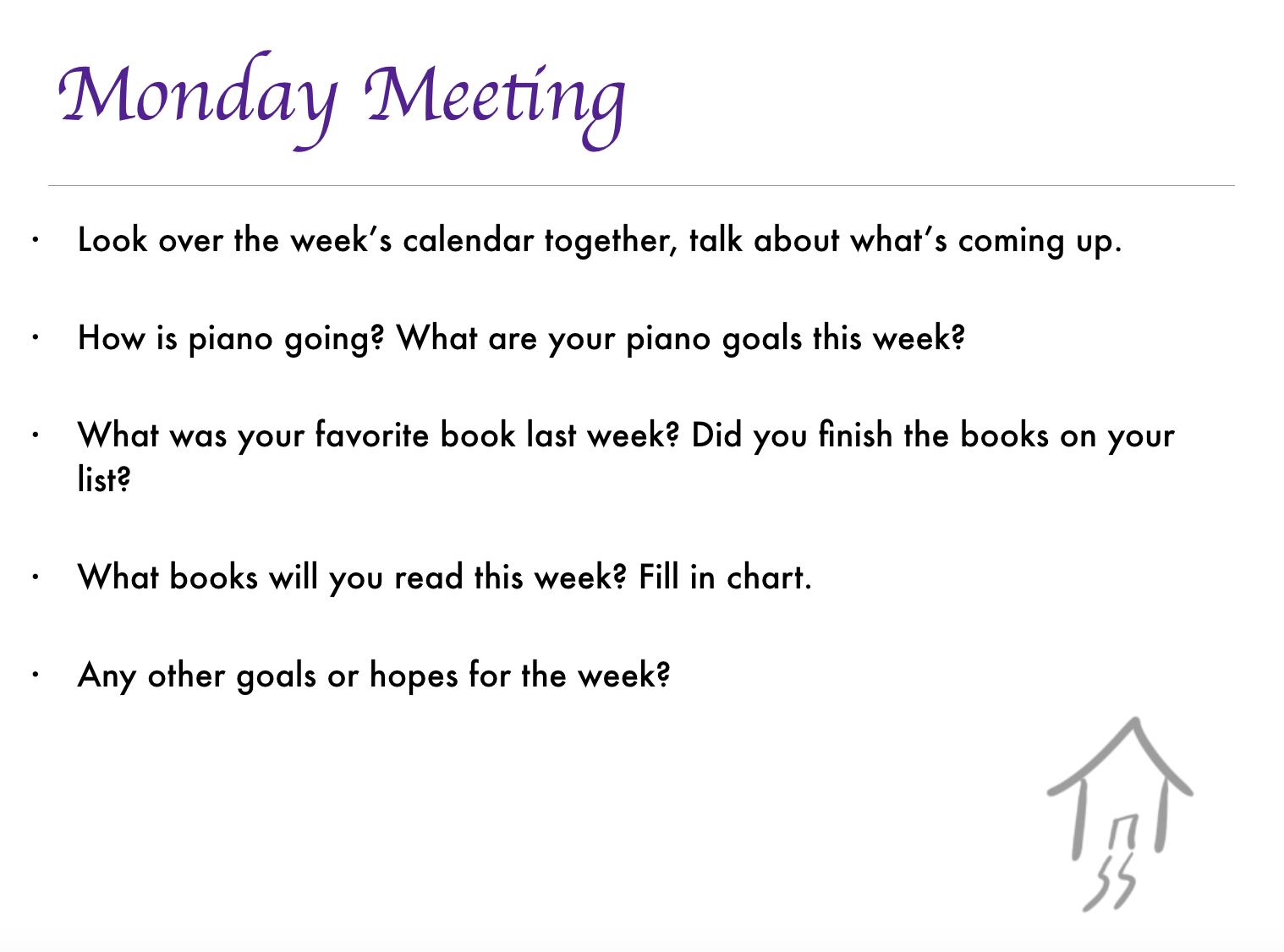
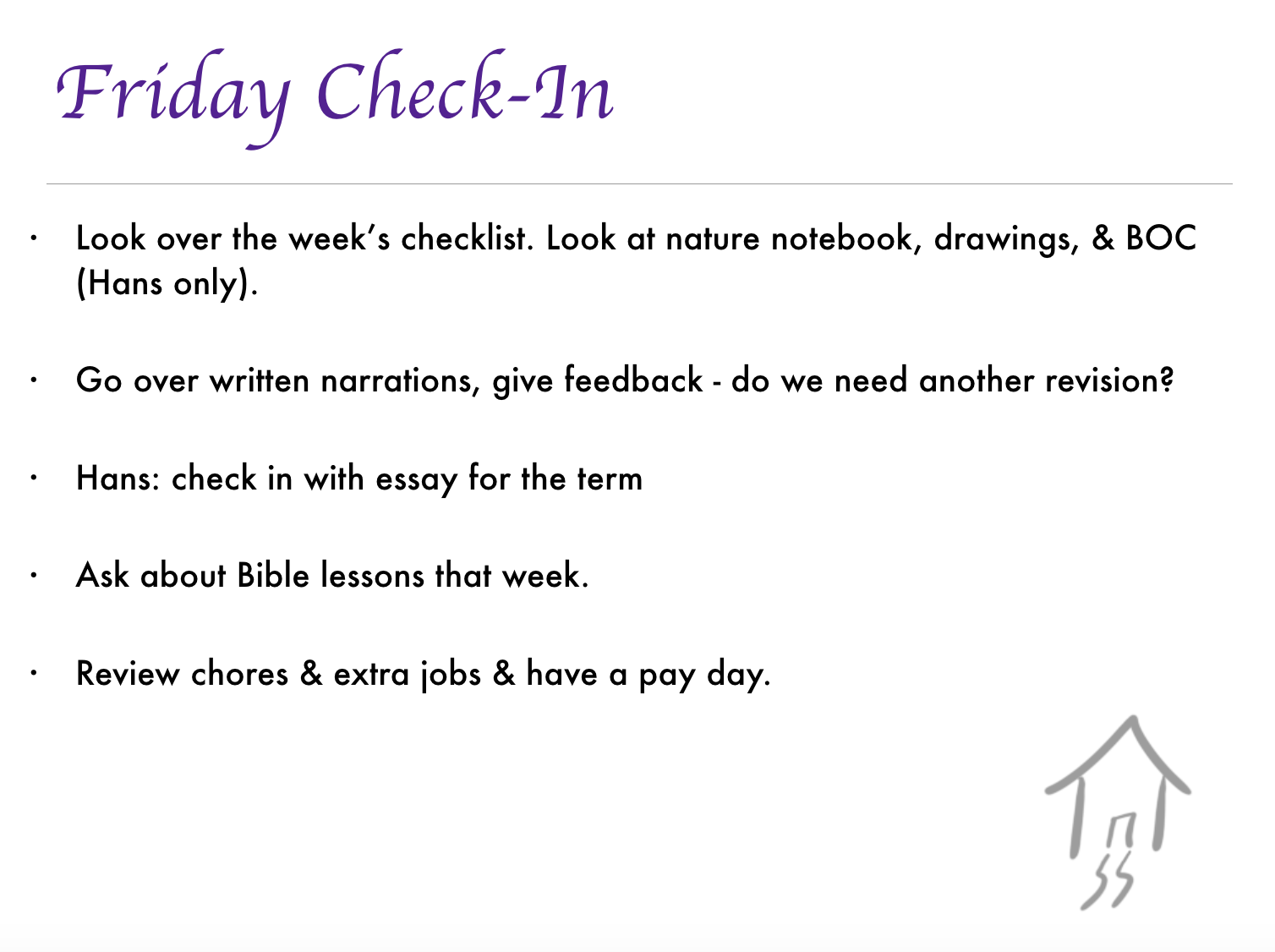
I still have a few more to make before our term starts up, but it is a planning step worth prioritizing.
Visualize your plan
What both the previous activities force me to do is visualize our typical homeschool day and make myself notes accordingly.
Visualizing is more than drafting out “do this, then do this” lists. It also involves foreseeing stall points and stumbling blocks so I can either set things up to sidestep them or at least go into the situation with a mental strategy to handle the push back.
For example, as I think through the day, I’m thinking about where the supplies are and how difficult they are to access and to put away. I’m thinking about where people might be doing their work – do they have options for quiet space? Where does their work go when they’re done? When do I correct it? When do they fix their mistakes?
Also, I know that one child will be stressed out by a new routine, so I budget time in the first week to ease him in. Another will be thrilled with new and will need time to go burn off energy afterwards. I think of little suggestions I can make when someone starts resisting or feeling overwhelmed – a cup of tea? a walk down the street? check the tomatoes and you can eat whatever you find? a glass of ice water and jumping jacks?
First I let myself visualize an ideal homeschool day, but then reality has to come alongside that. After a little fantasy, bring in my actual, real-life kids with their own agendas, opinions, and emotions – how can we all get along while moving forward and still be civil with each other at the end of the day?
One key: I hole up with headphones or go outside during piano practice!
It can be tricky to move from the big picture outlines and kid checklist plans to working out what a homeschool day will actually look like, but these three tools and practices help me do just that!
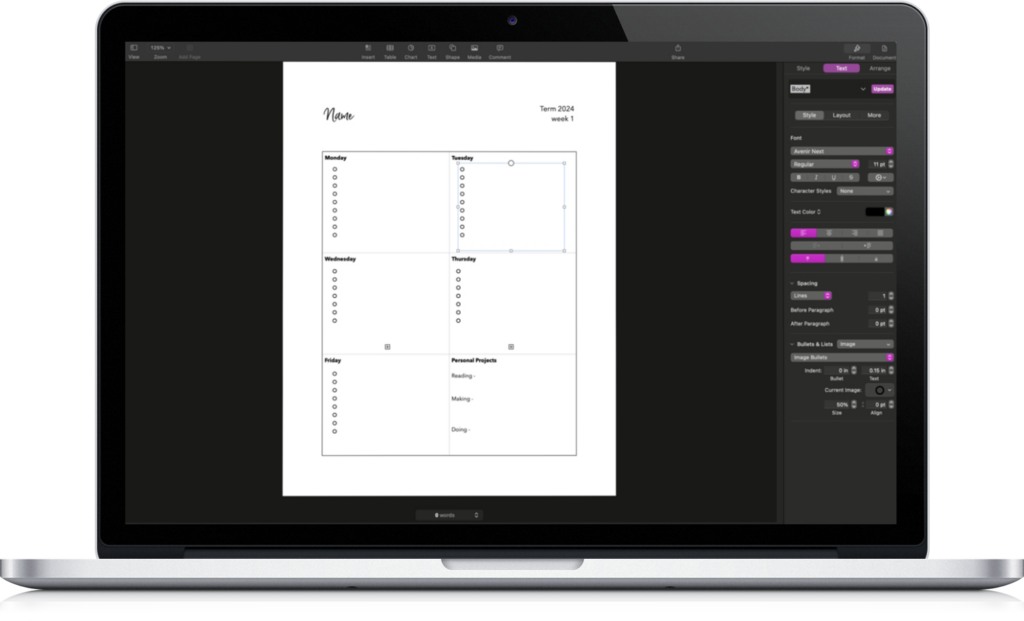
Get 5 of my favorite homeschool checklist templates!
Jumpstart your homeschool checklist practice by starting with one of my proven formats. Open, edit, and make them your own! Plus, get tips and followup, too –
Thanks for this! I, too, read MOTH several years ago and wanted to do something similar, but with tweaks. I appreciate the reminder because I had forgotten to implement this at the end of last school year – and was wondering why the days weren’t going smoothly! Question: how do your kids know what to do next – do you print this time budget for them to see? Also, kind of as a side note, how do you handle interruptions when you are doing one on one work with someone else- even if they know what they’re supposed to be doing? I have 4 kids, 9 and under, so really only one child is doing independent work, and actually he is the most distractible! Keep up the good work – love reading your blog.
“The problem there is that my expectations were unrealistic only because I wasn’t thinking through the whole picture.” – ah, yes, some of the best laid plans going astray!
I like the Procedure Chart idea. Sometimes when I plan too far in advance, by the time I go to implement the plan, I have totally lost my train of thought. A Procedure Chart would be very helpful in helping me to remember what I was trying to accomplish…thanks!
Lots of good advice here. Seasoned, wise, helpful. Thank you!
Also – I just have to say, I’m so glad I’m not the only one who needs to not be within earshot during piano practice. I always feel so guilty about that! Thanks for the permission to tune out. :)
Procedure Charts–genius! Making a note for my upcoming school planning session! I, too, heartily affirm not needing to be within earshot of piano/violin practice (headphones, door closed, retreat to the great outdoors when weather permits, etc.–I’ve developed lots of strategies :-) ). Another instrument practice tip that we religiously employ during the school year: someone practices BEFORE breakfast (but after the general wake up time) to get it done. I’ve found, too, that the morning piano practice slot doesn’t bother me so much, and I think it’s because I’m not returning phone calls, trying to teach a child, get reading done, etc. It’s a busy, general prep time, and the music just sort of adds to the background of getting laundry going, getting kids up and dressed, prepping breakfast: a joyful, busy chaos :-).
Oh that’s a great idea – during the general morning prep. It’s always crazy loud then anyway. I’ll try it!
The last paragraph resonated with me, as just this morning we signed up for a season of football and cheerleading. Preseason practice starts in two weeks, with practice every weeknight from 530-730, and then there will be games every Saturday and practices Tues, Weds & Thurs throughout the season. That’s a LOT for me to take on, work with, etc. Normally I would have said no, but my oldest was very enthusiastic about playing, and even started his own workouts to get ready, so I agreed. It helps that a friend has 2 boys playing as well and we can take turns getting the kids to practice, but I’ve been thinking today how that will change what our days look like.
Thanks for another great post!
Ah, Keynote for the procedure lists! Great idea. I have made procedure lists for several things because I know it is a brilliant idea, but I’ve struggled with where to keep them so I can get to them easily and actually remember to use them. I am allergic to paper (ok, not really) but I was having trouble figuring out a good way to have them on my phone, especially since I wanted to create them on my computer. I will give that a try! Thanks.
Allergic to paper-I love it! :-)